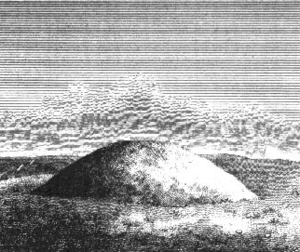Bowl barrow

A bowl barrow is a type of burial mound or tumulus. A barrow is a mound of earth used to cover a tomb. The bowl barrow gets its name from its resemblance to an upturned bowl. Related terms include cairn circle, cairn ring, howe, kerb cairn, tump and rotunda grave.[1]
Description

Bowl barrows were created from the
kerb
of stones or wooden posts.
Barrows were usually built in isolation in various situations on plains, valleys and hill slopes, although the most popular sites were those on hilltops. Bowl barrows were first identified in
ethnologist
.
British bowl barrows

English Heritage proposed the following classification of British bowl barrows:
- Type 1: Kerbless and ditchless barrows
- Type 2: Kerbless with continuous ditch
- Type 3: Kerbless with penannular ditch
- Type 4: Kerbless with segmented ditch
- Type 5: Kerbed but ditchless
- Type 6: Kerbed with continuous ditch
- Type 7: Kerbed with pennanular ditch
- Type 8: Kerbed with segmented ditch
- Type 9: Structured but ditchless
- Type 10: Structured with continuous ditch
- Type 11: Structured with penannular ditch
- Type 12: Structured with segmented ditch
Tump
Tump is
list of tumps, it can be seen that the term is used extensively in the Welsh Marches and its use extends beyond that, to Somerset, Wiltshire, Oxfordshire, and Buckinghamshire
.
See also
References
- ^ English Heritage (1988). "Monument protection programme. Monument class description". Archived from the original on 7 June 2011. Retrieved 14 August 2010.
External links
